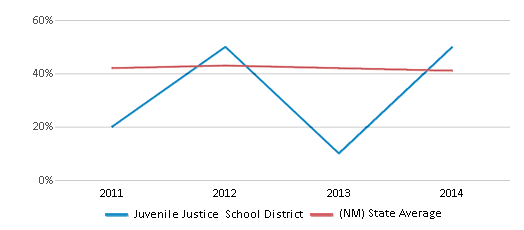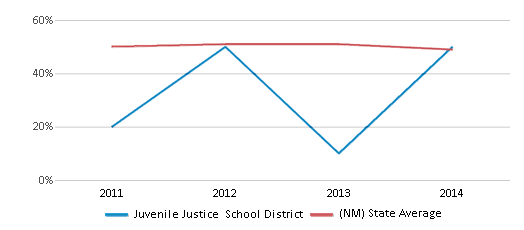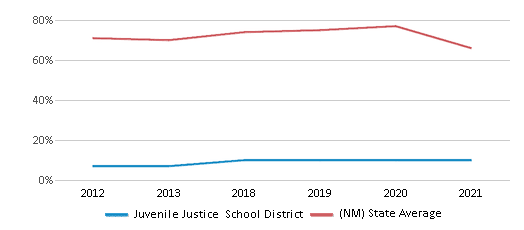Top Rankings
Juvenile Justice School District ranks among the top 20% of public school district in New Mexico for:
Category
Attribute
Student Attention
Lowest student:teacher ratio (Top 1%)
For the 2025 school year, there are 3 public schools serving 66 students in Juvenile Justice School District.
Public Schools in Juvenile Justice School District have a diversity score of 0.34, which is less than the New Mexico public school average of 0.56.
Minority enrollment is 91% of the student body (majority Hispanic), which is more than the New Mexico public school average of 80% (majority Hispanic).
Overview
This School District
This State (NM)
# Schools
3 Schools
926 Schools
# Students
66 Students
318,096 Students
# Teachers
18 Teachers
22,018 Teachers
Student : Teacher Ratio
4:1
4:1
District Rank
The school district's graduation rate of 10% has decreased from 6-9% over five school years.
Math Test Scores (% Proficient)
(13-14)<50%
41%

Reading/Language Arts Test Scores (% Proficient)
(13-14)<50%
49%

Graduation Rate
(20-21)≤10%
66%

Students by Ethnicity:
Diversity Score
0.34
0.56
# American Indian Students
2 Students
38,280 Students
% American Indian Students
3%
12%
# Asian Students
n/a
3,881 Students
% Asian Students
n/a
1%
# Hispanic Students
53 Students
198,105 Students
% Hispanic Students
80%
62%
# Black Students
5 Students
5,575 Students
% Black Students
8%
2%
# White Students
6 Students
64,514 Students
% White Students
9%
20%
# Hawaiian Students
n/a
396 Students
% Hawaiian Students
n/a
n/a
# Two or more races Students
n/a
7,345 Students
% of Two or more races Students
n/a
3%
Students by Grade:
# Students in PK Grade:
-
10,488
# Students in K Grade:
-
20,351
# Students in 1st Grade:
-
21,570
# Students in 2nd Grade:
-
22,782
# Students in 3rd Grade:
-
22,089
# Students in 4th Grade:
-
22,668
# Students in 5th Grade:
-
23,142
# Students in 6th Grade:
-
23,235
# Students in 7th Grade:
-
23,693
# Students in 8th Grade:
-
24,281
# Students in 9th Grade:
36
29,625
# Students in 10th Grade:
19
27,491
# Students in 11th Grade:
8
24,570
# Students in 12th Grade:
3
22,111
# Ungraded Students:
-
-
Best Juvenile Justice School District Public Schools (2025)
School
(Math and Reading Proficiency)
(Math and Reading Proficiency)
Location
Grades
Students
Rank: #11.
Foothill High School
Alternative School
(Math: <50% | Reading: <50% )
Rank:
Rank:
7/
Top 50%10
400 Edith Blvd Ne
Albuquerque, NM 87107
(505) 841-2400
Albuquerque, NM 87107
(505) 841-2400
Grades: 6-12
| 34 students
Rank: #22.
Aztec Youth Academy
Alternative School
(Math: <50% | Reading: <50% )
Rank:
Rank:
7/
Top 50%10
10015 Robert Larnson
Albuquerque, NM 87110
(505) 526-5900
Albuquerque, NM 87110
(505) 526-5900
Grades: 9-12
| 32 students
Rank: n/an/a
Camino Nuevo Youth
Alternative School
4050 Edith Blvd Ne
Albuquerque, NM 87107
(505) 841-2400
Albuquerque, NM 87107
(505) 841-2400
Grades: 6-12
| n/a students
Frequently Asked Questions
How many schools belong to Juvenile Justice School District?
Juvenile Justice School District manages 3 public schools serving 66 students.
What is the racial composition of students in Juvenile Justice School District?
80% of Juvenile Justice School District students are Hispanic, 9% of students are White, 8% of students are Black, and 3% of students are American Indian.
What is the student/teacher ratio of Juvenile Justice School District?
Juvenile Justice School District has a student/teacher ratio of 4:1, which is lower than the New Mexico state average of 14:1.
Recent Articles

How Scaffolding Could Change the Way Your Child Learns
This article explores the concept of instructional scaffolding, a teaching method that enhances learning by breaking down complex tasks into manageable parts. It highlights how scaffolding supports students in developing critical thinking skills and becoming more independent learners. The article discusses the benefits of scaffolding, including improved engagement and reduced anxiety, and provides strategies for its implementation across various educational levels.

The Impact of Coronavirus on Public Schools
This article discusses the widespread impact of COVID-19 on public schools, addressing issues such as school closures, remote learning challenges, effects on standardized testing, and concerns about student progress. It also provides tips for parents suddenly faced with homeschooling responsibilities.

February 05, 2025
Understanding the U.S. Department of Education: Structure, Impact, and EvolutionWe explore how the Department of Education shapes American education, from its cabinet-level leadership to its impact on millions of students, written for general audiences seeking clarity on this vital institution.





